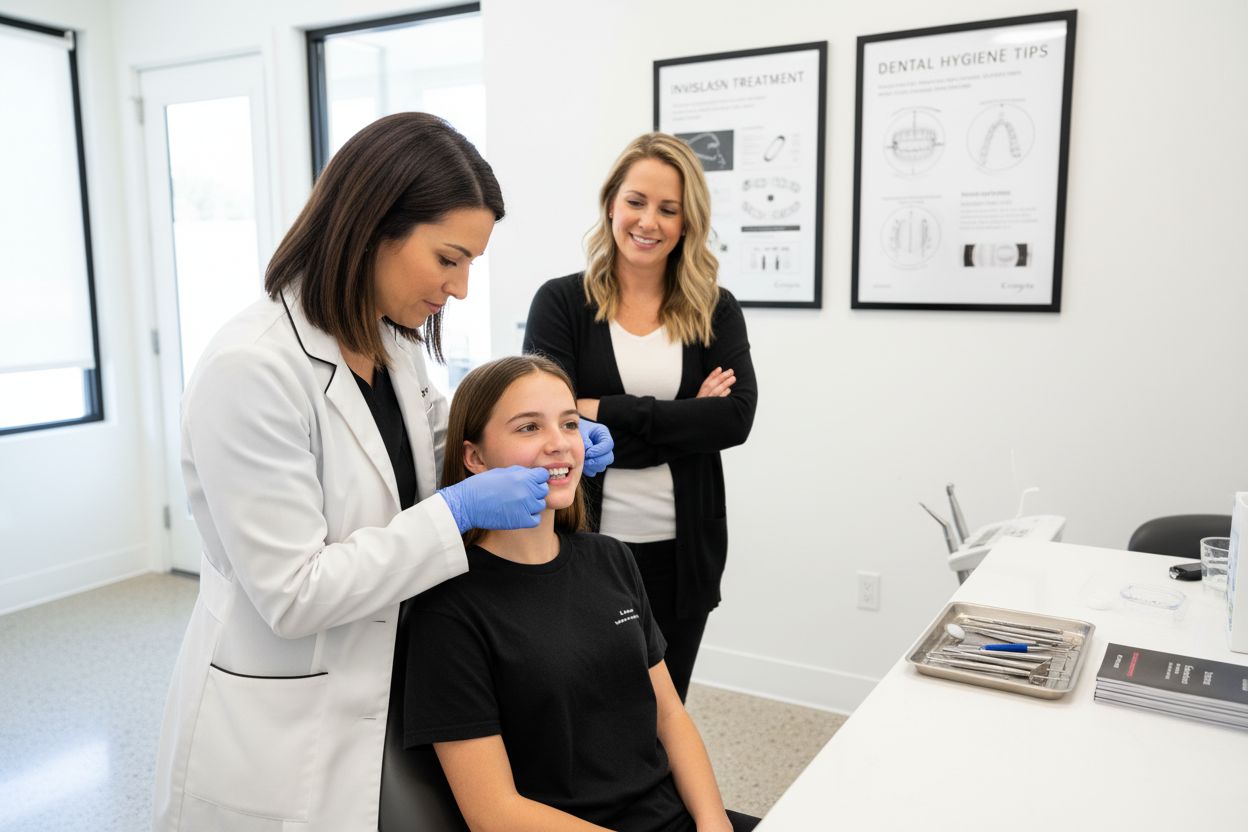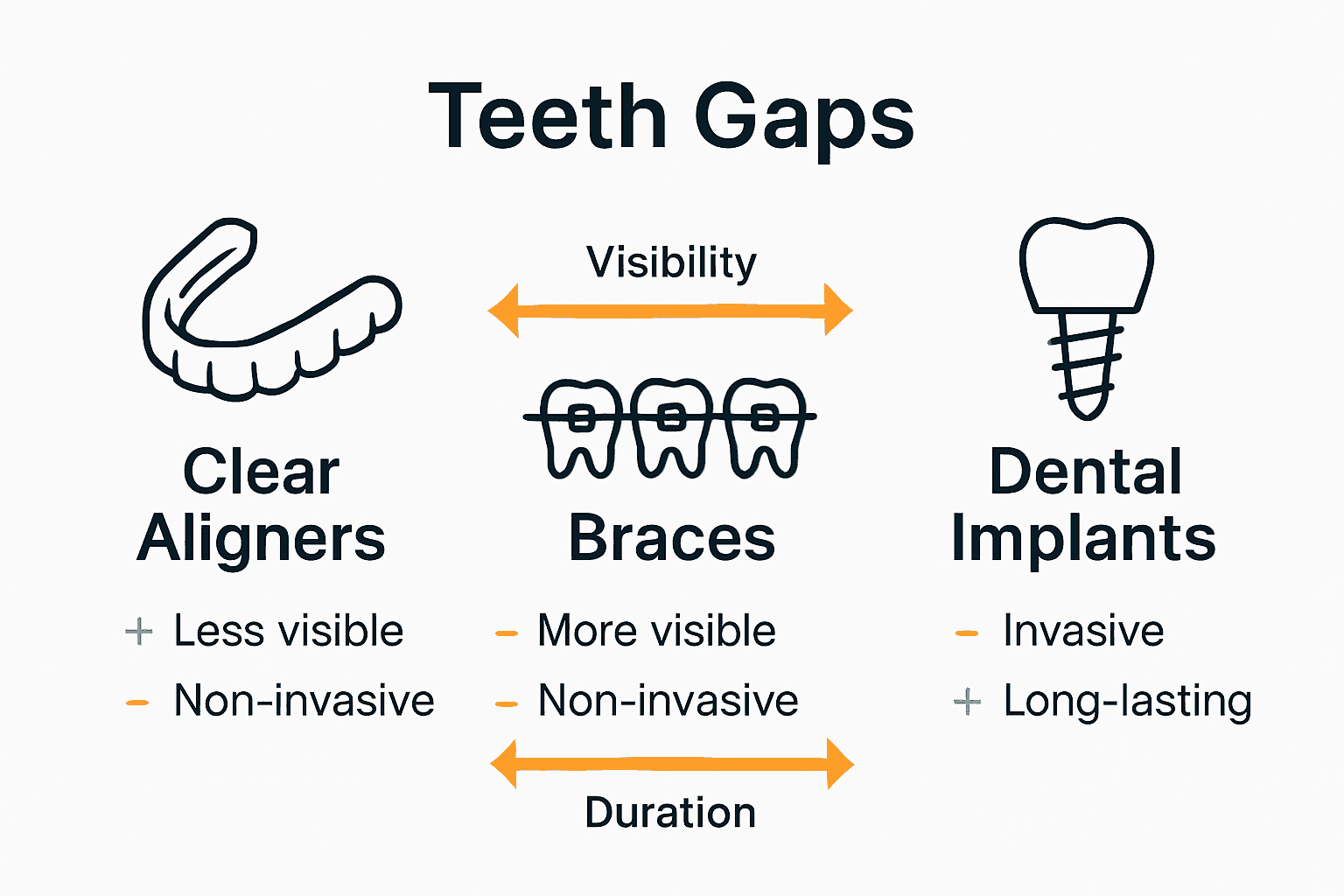Teeth Gap Solutions: How to Fix Gaps for All Ages
October 16, 2025
Teeth Gap Solutions: How to Fix Gaps for All Ages
Did you know that nearly one in four people develop noticeable spaces between their teeth at some point in life? These gaps might seem harmless, but they can sometimes signal deeper dental issues or disrupt your confidence. Understanding what causes those spaces and learning your options turns confusion into clear choices. Whether the gaps are minor or seem to grow over time, knowing the steps to address and manage them makes your path to a healthier, more attractive smile far smoother.
Quick Summary
| Key Point | Explanation |
|---|---|
| 1. Assess teeth gap causes first | Identify underlying issues such as genetics, habits, or medical conditions that may be causing your dental gaps. |
| 2. Schedule a professional evaluation | A thorough orthodontic consultation is essential to understand your specific dental structure and potential treatment plans. |
| 3. Explore multiple treatment options | Treatment can include retainers, implants, fillings, clear aligners, or braces; discuss these with your orthodontist based on your needs. |
| 4. Prepare for ongoing treatment and care | Maintain excellent oral hygiene and attend regular adjustments to ensure the success of your selected treatment plan. |
| 5. Commit to post-treatment care | Wear retainers as prescribed to maintain results and prevent teeth from shifting back to their original positions. |
Table of Contents
- Step 1: Assess Teeth Gap Causes And Options
- Step 2: Schedule A Professional Orthodontic Evaluation
- Step 3: Select The Best Teeth Gap Solution
- Step 4: Prepare For And Begin Treatment
- Step 5: Monitor Progress And Adjust Care
- Step 6: Verify Results And Maintain Your Smile
Step 1: Assess Teeth Gap Causes and Options
Let’s figure out what might be creating those unexpected spaces between your teeth. Understanding the root causes is your first step toward a confident smile.
Teeth gaps happen more often than you might think. According to Apollo Hospitals, these spaces can emerge from multiple sources – some genetic, some behavioral. The most common culprits include childhood habits like thumb sucking, genetic predispositions where tooth and jaw sizes don’t perfectly match, and sometimes unexpected medical conditions.
Start by examining your specific situation. Are the gaps between your front teeth? Those spaces even have a medical name: diastema. Wikipedia explains that these front tooth gaps can result from several fascinating factors:
- An oversized labial frenum (the tissue connecting your upper lip to the gum)
- Potential periodontal disease causing bone loss
- Extra teeth hiding in your jaw
- Mismatched jaw and tooth sizes
- Tongue thrusting habits
Take a close look in the mirror. Notice any patterns in how your teeth sit. Do they seem to be pushing outward? Are the gaps consistent or changing? Sometimes tiny shifts can indicate underlying issues that need professional assessment.
Pro Tip: Not all gaps are problematic. Some are purely cosmetic and pose no health risks.
If you’re seeing consistent spacing or experiencing discomfort, it’s time to consult an orthodontic professional. They can perform precise measurements and determine whether your teeth gaps require intervention or are simply a unique feature of your smile.
What comes next? A comprehensive examination that will map out your specific dental landscape and potential treatment paths.
Step 2: Schedule a Professional Orthodontic Evaluation
Time to take your teeth gap journey to the next level by booking a professional orthodontic consultation. This crucial step transforms your personal observations into a scientifically backed treatment plan.
Scheduling an orthodontic evaluation isn’t just another medical appointment. According to research published in the American Journal of Orthodontics and Dentofacial Orthopedics, professional diagnosis provides the roadmap for precise treatment strategies.
Start by gathering your dental history. Pull together any previous x-rays, records of past dental work, and a list of concerns about your teeth gaps. Most orthodontic offices appreciate patients who come prepared.
When calling to schedule, ask about:
- Initial consultation fees
- Required documentation
- Potential insurance coverage
- Duration of first appointment
During your first visit, expect a comprehensive examination. The orthodontist will likely perform detailed imaging and measurements to understand your unique dental structure. They’ll assess whether your teeth gaps require intervention and recommend personalized treatment options.
Pro Tip: Bring a list of questions and bring a family member or friend for support and an extra set of ears.
Professional evaluation helps determine the most appropriate approach. As Dental Clinic Guide notes, this might include recommending braces, clear aligners, or additional procedures like frenectomy.
What comes next? A detailed treatment plan tailored specifically to your dental needs and smile goals.
Step 3: Select the Best Teeth Gap Solution
With your professional evaluation complete, it’s time to explore the most effective solution for closing those teeth gaps. Your unique dental landscape means there’s no one size fits all approach.
Your orthodontist will likely present multiple treatment options tailored to your specific dental structure. According to FEAU Healthcare, you have several potential pathways to address those spaces between your teeth.
Let’s break down your potential treatment strategies:
-
Orthodontic Retainers: Perfect for minor gaps and offering a non-invasive approach. These removable devices gradually shift teeth into proper alignment.
-
Dental Implants: An excellent solution if gaps result from missing teeth. These permanent restorations seamlessly fill spaces while maintaining your natural smile aesthetics.
-
Tooth Colored Fillings: Ideal for small gaps caused by decay or minor damage. These subtle corrections can create a more uniform appearance.
-
Clear Aligners: A modern alternative to traditional braces that provide discretion and flexibility during treatment.
Consider your lifestyle personal preferences and budget when making this decision. Some treatments require more commitment than others. Your comfort matters just as much as the clinical effectiveness.

Pro Tip: Ask your orthodontist about treatment duration visual mock ups and potential long term outcomes for each option.
Consult closely with your orthodontic professional. They can provide personalized recommendations based on your specific dental anatomy and treatment goals.
Here’s a comparison of common teeth gap treatment options:

| Treatment Option | Best For | Pros | Considerations |
|---|---|---|---|
| Orthodontic Retainers | Minor gaps | Removable Non-invasive |
May require long-term use |
| Dental Implants | Gaps from missing teeth | Permanent Natural appearance |
Surgical procedure Costly |
| Tooth Colored Fillings | Small gaps or chipped teeth | Quick fix Natural look |
Best for minimal corrections |
| Clear Aligners | Moderate gaps | Discreet Removable |
Must wear 20+ hours/day |
| Braces | Complex/multiple gaps | Effective for severe alignment | Visible Longer duration |
What comes next? Developing a comprehensive treatment plan that transforms your smile with precision and care.
Step 4: Prepare for and Begin Treatment
You have selected your teeth gap solution and now it is time to dive into the exciting journey of transforming your smile. Preparation is key to making your treatment smooth and successful.
According to the Dental Clinic Guide, treatment preparation involves strategic planning and commitment. Expect scheduled adjustments approximately every 4 to 6 weeks to track your progress and make necessary modifications.
Start by creating a comprehensive oral hygiene routine. Your new dental apparatus whether braces or clear aligners will require extra attention. Stock up on specialized cleaning tools like orthodontic brushes interdental cleaners and recommended mouth rinses.
Know what to expect during your initial appointments:
- Detailed measurements and impressions of your teeth
- Potential interproximal reduction to facilitate tooth movement
- Installation of braces or first set of clear aligners
- Comprehensive instructions on maintenance and care
Mental preparation matters as much as physical preparation. Treatment can feel overwhelming initially but remember thousands of people successfully navigate orthodontic journeys every day.
Pro Tip: Take before photos. You will want to document your transformation and celebrate your progress.
Create a support system. Tell friends and family about your treatment. Their encouragement can make a significant difference in maintaining motivation and consistency.
What comes next? Adapting to your new dental solution and embracing the journey toward your dream smile.
Step 5: Monitor Progress and Adjust Care
Now that your teeth gap treatment is underway, tracking your progress becomes crucial. Think of this stage as your personal dental transformation journey with regular checkpoints and potential course corrections.
According to the Dental Clinic Guide, successful treatment requires consistent monitoring and patient compliance. Your scheduled appointments every 4 to 6 weeks will be key opportunities to assess how your teeth are responding to treatment.
Research from advanced clinical studies reveals fascinating insights. As findings from ArXiv indicate, tooth movements can be meticulously tracked through intra oral scans. These scans help orthodontists understand how your teeth are actually moving compared to the initial treatment projection.
What should you focus on during this monitoring phase?
- Attend all scheduled adjustment appointments
- Maintain impeccable oral hygiene
- Take progress photos at home
- Track any discomfort or unexpected changes
- Follow your orthodontist’s specific care instructions precisely
Your active participation matters more than you might realize. These treatments are collaborative efforts between you and your dental professional.
Pro Tip: Keep a treatment journal. Document your observations feelings and progress to stay motivated and provide valuable insights during appointments.
Be patient with yourself. Tooth movement is a gradual process and everyone’s journey looks slightly different. Some weeks will show more progress than others.
What comes next? Continuing your commitment to the treatment plan and staying excited about your emerging new smile.
Step 6: Verify Results and Maintain Your Smile
Congratulations! You have successfully navigated your teeth gap transformation. Now comes the equally important phase of preserving your beautiful new smile and preventing any potential regression.
According to the Dental Clinic Guide, post treatment retention is absolutely critical. Experts recommend full time retainer use for 6 to 12 months followed by consistent nighttime wear to maintain your results.
Research offers fascinating insights into long term smile maintenance. A study published in PubMed revealed that fixed bonded retainers can last an impressive average of 17 years with just a 2% annual breakage risk. This means your hard earned smile transformation can remain stable with proper care.
Your retention strategy should include:
- Regular follow up appointments with your orthodontist
- Strict adherence to retainer wearing instructions
- Maintaining excellent oral hygiene
- Protecting your teeth during physical activities
- Monitoring any subtle shifts in tooth alignment
Choosing between fixed and removable retainers depends on your specific case and personal compliance. Discuss the most suitable option with your orthodontic professional.
Pro Tip: Take annual progress photos to track your smile’s long term stability and celebrate your journey.
Remember that maintaining your smile is an ongoing commitment. Your dedication during the retention phase will determine the longevity of your teeth gap correction.
What comes next? Enjoying your confident new smile and showing it off to the world.
Ready for a Confident Smile? Start Closing Your Teeth Gaps with Trusted Experts
If you feel self-conscious about teeth gaps or worry about shifting teeth and long-term dental health, you are not alone. The steps you just read about—including professional evaluations, custom treatment plans, and retainer care—are not just theory. These solutions are practiced daily by specialists who understand how a small gap can impact your confidence and well-being.

Glow Orthodontics is here to guide you from your very first consultation to your final check-up. Our friendly and experienced team offers personalized care for all ages in Langley, helping you choose options like Invisalign, orthodontic retainers, or advanced braces that fit your needs and lifestyle. Visit our welcoming homepage to read real patient testimonials, discover more about our step-by-step process, and book your appointment with ease. Take the first step now. A closed gap and a glowing smile are closer than you think. Visit Glow Orthodontics and schedule your friendly consultation today.
Frequently Asked Questions
What are the common causes of teeth gaps?
Teeth gaps can be caused by several factors including genetic predispositions, childhood habits like thumb sucking, and periodontal disease. To identify the cause of your specific gaps, observe where they are located and consider consulting an orthodontist for a professional assessment.
How do I prepare for my orthodontic evaluation?
To prepare for your orthodontic evaluation, gather your dental history, including any previous x-rays or records of dental work. Make a list of your concerns regarding your teeth gaps to discuss during your appointment, ensuring a productive consultation.
What treatment options are available for closing teeth gaps?
There are various treatment options such as orthodontic retainers for minor gaps, dental implants for missing teeth, and clear aligners for moderate gaps. Discuss these options with your orthodontist, as they will recommend the most suitable solution based on your unique dental structure and goals.
How often will I need adjustments during my treatment?
Most orthodontic treatments require adjustments every 4 to 6 weeks to monitor progress and make necessary changes. Schedule these appointments in advance to stay on track and ensure your treatment is progressing smoothly.
What should I do to maintain my smile after treatment?
After treatment, it’s essential to wear retainers as instructed by your orthodontist to prevent teeth from shifting back. Regular follow-up appointments and maintaining good oral hygiene will also help preserve your beautiful new smile.
How long does it typically take to see results from teeth gap treatments?
The time required to see results varies by treatment method—orthodontic retainers may show changes within a few months, while dental implants might take longer due to healing. Follow your orthodontist’s guidance and stay committed to your care routine to achieve optimal results.